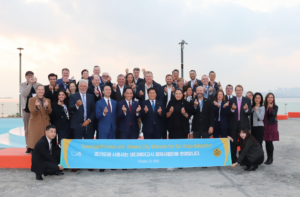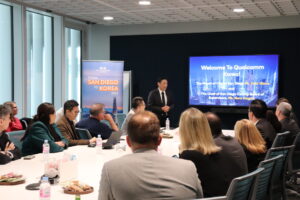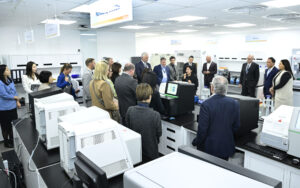From San Diego to Korea: Collaborative partnerships to strengthen global competitiveness
It has been six years since World Trade Center San Diego—which EDC operates on behalf of the Port, the Airport, and the City of San Diego—ran its very first trade mission. Since then, we have taken annual targeted, cross-sector delegations to Canada, the UK, Japan, Germany, and the Netherlands. Led by Mayors and Members of Congress, flanked by Port, Airport, and University leadership, and accompanied by senior executives from our most innovative firms, these trade missions connect San Diego companies large and small to international markets, seek foreign investment that creates new jobs in our region, and tell the San Diego story: one of life-changing innovation and collaboration.
This year’s destination: Korea. And like every other year, San Diego showed up and impressed. Led by Mayor Todd Gloria—and joined this time by SANDAG and County Board of Supervisors Chairwoman Nora Vargas—this year’s trade delegation of more than 30 civic, academic, and corporate partners also included peer organizations like Biocom and the Tijuana and Imperial Valley EDCs, as well as companies like Qualcomm, Illumina, Dexcom, ASML, General Dynamics NASSCO, and more.
At a time when more than a trillion dollars of federal investments are aimed at modernizing American infrastructure, enabling a green energy transition, and building domestic capacity in strategic industries like semiconductors and biomanufacturing, Korea is a natural partner for the United States, as evidenced by the deepening collaboration between our two countries. Korea is second only to China in manufacturing intensity, and Korean firms produce almost 25 percent of all EV batteries and almost 60 percent of global memory chips used in phones and laptops.
There is also perhaps no more complementary partner for an innovation incubator like San Diego than a country that scales innovation more efficiently than anywhere else.
The trade mission opened with a Sunday visit to the residence of the Governor of Gyeonggi-do, Korea’s largest and most dynamic province. Governor Kim and his cabinet hosted us for a roundtable discussion focused on revitalizing the MOU between the state of California and Gyeonggi. We delivered a letter from Governor Newsom and invited a return delegation to visit California in 2024 to continue the conversation on economic cooperation.

This set the stage for a whirlwind four days packed from morning to night with more than 15 briefings, meetings, and events:
- With the help of Dentons and the U.S. Embassy, we convened representatives from more than 30 of the largest Korean companies for an Invest San Diego Luncheon. We provided an economic overview of investment opportunities throughout the binational mega-region, followed by quick pitches on manufacturing, energy, innovation, and real estate projects from Tijuana, Imperial Valley, and San Diego.
- We visited the rapidly growing Korean offices of Illumina and Qualcomm, and announced a new partnership between San Diego’s Dexcom and Korean tech giant Kakao.
- We toured and met with leadership of Samsung Biologics, which in just a few years has grown into the world’s largest contract manufacturer of biologics and is considering the location of a large investment in the United States.
- We celebrated partnerships between UCSD and SDSU—both developing new state of the art innovation districts—and Seoul National and Yonsei Universities, two of South Korea’s finest.
- We spent a day in the City of Incheon—a city of millions that has been master planned and developed on land reclaimed from the ocean over the last two decades and is now the innovation hub of the greater Seoul area. Incheon is also home to the international airport, completed in just eight years, as well as the Port, completed in four.
Finally, we closed the trip with a VIP meeting with U.S. Ambassador to Korea Philip Goldberg to discuss the evolving political and economic environment in the region, followed by a reception at the Ambassador’s residence in the former legation district of Seoul. As is the tradition on these trade missions, this reception gave us an opportunity to reconnect with the hundreds of partners we met during the week, cement new friendships (and perhaps most importantly, make sure everyone knows which team to root for when the Padres play the Dodgers in the MLB opener in Seoul next March).
We returned home this week to a region in which the entire urban core is being reimagined—with massive mixed-use projects under construction from the border to the bay; to a country attempting to rebuild its infrastructure and establish new industries to take us into a cleaner, smarter future; and in a post-pandemic world where supply chains and geopolitical alliances are shifting rapidly.
One thing is clear: Our binational region has always been a remarkable place, but at this moment—with San Diego’s innovation ecosystem, Imperial Valley’s clean energy leadership, and Tijuana’s advanced manufacturing prowess—we can compete like never before. Add the right international partnerships like those we are building in Korea and elsewhere, and we have all the necessary pieces to anchor the supply chains of the future: collaboratively, efficiently, and sustainably.
Thank you to our sponsors Qualcomm, Dentons, and Townshend Venture Advisors, as well our partner the U.S. Embassy in South Korea for support on this trade mission.
Best,

Nikia Clarke
Chief Strategy Officer, EDC; Exec. Director, WTCSD


Learn about WTCSD’s trade missions